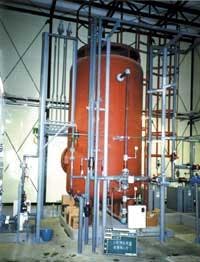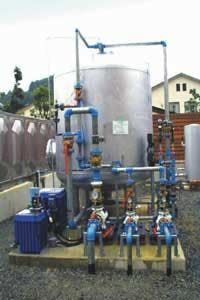ADI system removes arsenic from drinking water in New Zealand
By Eric Winchester
Three years of regular analysis of drinking water treated by ADI International's MEDIA G2® in Onemana, New Zealand confirms that the iron-based adsorptive filter media system consistently reduces arsenic levels from 26 parts per billion (ppb) in raw water to a level below five ppb.
Two boreholes, Tuna Place and The Grove, supply water for the Onemana community. Daily demand varies between 250 cubic metres (m3) in the winter to 450 m3 in summer months. This water, extracted from a nominal 50-m-depth, is thermal in nature having a low pH and moderately high in minerals, one of which is arsenic at a level of up to 26 ppb.
Numerous strategies can effectively remove arsenic from drinking water, including media filtration, iron precipitation, ion exchange, reverse osmosis (both bulk and point of use) and dilution. None were considered for the Onemana situation given the necessary capital outlay, operational costs, water wastage and complexity of each treatment process.
Murray Haycock of Designwater Ltd. in Whitiango, New Zealand made an enquiry on behalf of its client, the Thames Coromandel District Council and their engineering service provider Montgomery Watson Harza, on a flow-through process manufactured by ADI International of Fredericton, New Brunswick, Canada. This process uses a patented media expressly formulated to achieve a "bonding" to arsenic upon contact. The plant needed was small, simple in operation, automated and required little operator input.
ADI International Inc. developed and markets an iron-based adsorptive filter media system, trade named - MEDIA G2®. MEDIA G2® is a natural mineral, impregnated with a substantial quantity of ferric hydroxide, and received a United States patent in March 2001. Used in a conventional filtering arrangement, arsenic-contaminated water flows downward through the filter bed where the iron on the media attracts and binds arsenic ions to the media substrate through a process of chemi-sorption. Tested and used in full-scale water treatment applications, MEDIA G2® reduces arsenic from 1200 ppb to less than five ppb. In most applications, the treated water will contain less than two ppb arsenic.
MEDIA G2® systems use an adsorptive process for arsenic removal, taking advantage of the natural affinity of iron to attract arsenic ions from the water. This takes place at the favourable pH range of 5.0 to 7.5. Extensive testing demonstrated the ability of the media to adsorb both trivalent (arsenite) and pentavalent (arsenate) arsenic; however, arsenate is easier to adsorb than arsenite. "Easier" means that the treatment process will produce an effluent that is lower in total arsenic concentration and exhibit a higher adsorption capacity (life of media before arsenic breakthrough) than if the arsenic was all in the trivalent form. Some adsorptive media, including MEDIA G2®, allow for oxidation of arsenite on the media surface during the treatment process.
The Thames Coromandel District Council purchased and subsequently commissioned the ADI treatment plant in March 1999, with warranty support provided by the New Zealand agency Filtration Technology Ltd of Auckland. Since its start-up, only five 20-minute duration backwash cycles have been undertaken during the three years of plant operation. The media to this time has not required "regeneration."
The ability of MEDIA G2® to be regenerated, in-situ, offers many water utilities a very economical solution, particularly when arsenic concentration is more than 50 ppb and large throughputs are desired. MEDIA G2® can be regenerated up to five times before disposal. This is accomplished by flowing a 0.5% caustic solution downward through the filter bed for 45 minutes, effectively de-sorbing 95% of the arsenic from the media. This is followed by a downward rinse with a 0.5 % acid solution for 20 minutes to re-neutralise the filter bed. When these two waste solutions are combined, the de-sorbed arsenic combines with some of the iron, which is stripped during the acid rinse, to form insoluble ferric arsenate. In this form, the waste is non-hazardous according to the US Environmental Protection Agency's Toxicity Characteristic Leaching Procedure (TCLP). MEDIA G2® loses only 10% of its adsorption capacity per regeneration event. After five regeneration cycles, it should be replaced. Tests have also shown that MEDIA G2®, when saturated with arsenic, easily passes the TCLP as non-hazardous waste.
The amount of waste from normal back washing and regeneration is very small. Typically, an ADI system will produce 99.8% of treated water, i.e., less than 0.2% wastage. The recovery can be increased to 99.99% with reclaim and recycle of backwash and regeneration water. The system is particularly suitable for water-scarce communities, and where no discharge location for a liquid waste stream is available.
Other contaminants in natural water, including silica, hardness, sulphates, chlorides, iron and manganese, adversely affect many arsenic removal processes. These elements can affect adsorption efficiency and performance. Some processes will require pre-treatment to remove these contaminants. MEDIA G2® is proven to be unaffected by the aforementioned elements at concentrations up to, or even exceeding, maximum allowable drinking water concentrations. An ADI system in Michigan, USA has been in operation for four years, removing arsenic from 40 ppb to less than two ppb, in the presence of silica (22 mg/L), iron at 1.2 mg/L and hardness at over 350 mg/L as CaCO3. Tests have shown that MEDIA G27 is only slightly affected when sulphates and chlorides are over 500 mg/L.
Author's noteEric Winchester is the vice president of water treatment systems for ADI International Inc., based in Fredericton, New Brunswick, Canada. ADI's Media G2 is patented in the USA (March 2001) and Bangladesh (2002), and awaiting patents in Japan and Canada. Media G2 is certified to NSF Standard 61, and its performance has been verified under Canada's ETV Program, and is approved by the Japanese Water Works Authority for use in drinking water treatment. ADI won the National Award of Merit from the Association of Consulting Engineers of Canada for an installed plant in Holly, Michigan, USA, in February 1999.
High arsenic levels in Japan reduced
More than an estimated 1,000 hot spring holiday locations in Japan do not comply with Japanese government regulations that allow a maximum arsenic concentration of 100 ppb in discharge water. Arsenic concentrations have been measured from 300 ppb to more than 1200 ppb.
Several ADI MEDIA G2® systems from ADI, however, are now reducing high arsenic levels in discharged geothermal water in Sapporo and Nagano following a successful pilot test of a unit shipped to Aqua-Plant Construction Ltd of Sendai, Japan in 1999. The pilot unit succeeded in reducing arsenic levels in the geothermal water to meet the Japanese regulation.
Japan is well known for its many volcanoes, which have resulted in the use of geothermal water for hot springs (onsen). Many Japanese people enjoy their holidays in hot springs, usually found at resort hotels and inns. To take a bath in an onsen is very relaxing, and some claim it is effective in curing illnesses and soothing physical injury. Many kinds of onsen exist depending on the mineral content and amount of minerals in the water.
Geothermal water, having a temperature of 110ºF to 125º F, is pumped from drilled wells, flows through the onsen, and then discharged to open or closed storm drains. The discharge quality presents problems to onsen operators because the Japanese government is beginning to enforce its regulations on the maximum allowable concentration of arsenic in the discharge water.
Various chemical and physical treatment methods have been tried, with little success, given the chemical make-up of the water. Besides very high arsenic concentrations, a typical onsen discharge water contains nearly 20,000 ppm of total dissolved solids, hence the claims of high mineral content reputed to offer medicinal benefits. Adsorption methods for arsenic removal did not seem a likely candidate as a treatment with sulphate at 1500 ppm, chloride at 5500 ppm, sodium at 5000 ppm, along with many other potentially interfering elements.
MEDIA G2®, however, is well suited for high arsenic concentrations — the higher the concentration of arsenic, the higher the adsorption capacity of adsorption media. MEDIA G2® appears to tolerate high sulphate, chloride and sodium levels, and its ability to be easily regenerated, means that the process is economical for hot spring discharges. The initial concern was the high temperature of water to be treated. In general, chemical reactions go faster to completion and this proved to be the case for hot spring water.
Not surprisingly, arsenic is also found in drinking water wells in Japan. The Japanese Water Works Authority certified MEDIA G2® for use in drinking water applications in 2001. Subsequently, two full-scale arsenic removal systems were installed - one in the City of Fukuoka, on the Island of Honshu, and one for Sharp Electronics in Hiroshima. Seven months of successful pilot testing was completed for a municipality on the island of Hokkaido, where a 3,000 cubic metre per day plant is proposed.



